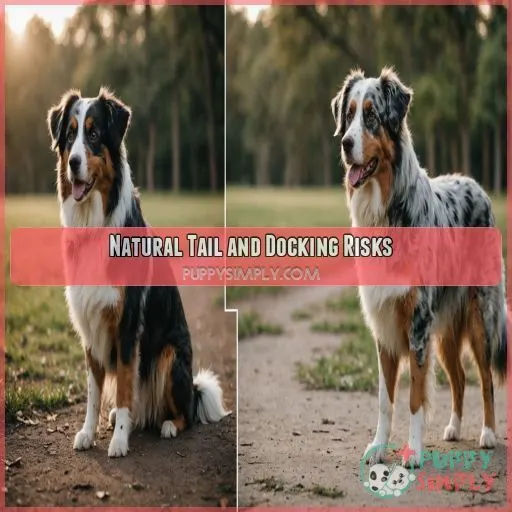This site is supported by our readers. We may earn a commission, at no cost to you, if you purchase through links.

If you’re wondering whether to dock your Aussie’s tail, you’re not alone.
While some swear by the procedure to prevent injuries, others argue it’s unnecessary and painful.
The truth is, tail docking, also known as Australian Shepherd tail amputation, is a serious decision that requires careful consideration.
It can lead to chronic pain and nerve damage, but it can also affect your dog’s ability to communicate.
So, what’s the best choice for your furry friend?
Let’s weigh the pros and cons and explore the facts together.
Table Of Contents
- Key Takeaways
- Why Australian Shepherd Tails Are Cut
- Natural Tail and Docking Risks
- Australian Shepherd Tail Amputation
- Tail Amputation Surgery and Recovery
- Life After Tail Amputation
- Australian Shepherd Tail Types and Variations
- Responsible Dog Ownership and Tail Care
- Frequently Asked Questions (FAQs)
- Why do they cut the tails off Australian Shepherds?
- Can Australian Shepherds be born without tails?
- Is tail docking cruel?
- What is the standard tail docking for Australian Shepherds?
- What are the historical reasons behind tail docking in dogs?
- Are Australian Shepherds born with naturally short tails common?
- Can tail docking be performed for non-cosmetic purposes in Aussies?
- How does tail docking affect an Australian Shepherds balance?
- Is tail amputation a painful procedure for Australian Shepherds?
- Conclusion
Key Takeaways
- You’re probably worried about your Australian Shepherd’s tail amputation, but don’t worry, with proper care, your furry friend will adapt surprisingly well. In fact, many dogs learn to live without their tails and still manage to communicate and balance just fine—it’s like they’re saying, "Hey, I’ve got this!"
- As you weigh the pros and cons of tail docking, remember that it’s a serious decision that requires careful consideration. Don’t rush into it—take your time, consult with a vet, and think about what’s best for your Aussie’s health and well-being.
- Tail injuries can happen, especially if your Aussie loves to chase its tail (who doesn’t, right?). But the good news is that tail injuries are relatively rare, and many can be prevented with proper care and attention. So, keep an eye on that tail and make sure your furry friend is safe and sound!
- When it comes to communication, a docked tail can be a game-changer for your Aussie. Since dogs use their tails to convey emotions, a missing tail can lead to misunderstandings. But don’t worry, your Aussie will adapt, and with a little patience and understanding, you’ll be able to read their new body language in no time.
Why Australian Shepherd Tails Are Cut
As an Australian Shepherd owner, you may have wondered why some breeders and veterinarians recommend docking your dog’s tail. The answer lies in a mix of historical, cosmetic, and medical reasons that have evolved over time, and you should really weigh the pros and cons before making a decision.
History of Tail Docking in Australian Shepherds
You’re likely wondering why Australian Shepherd tails are cut. Historically, tail docking was done to prevent injuries in working dogs, particularly hunting breeds. However, the practice has also been influenced by breed standards, cosmetic preferences, and misconceptions about rabies prevention. The Australian Shepherd breed has been shaped by these factors, leading to a long-standing tradition of tail docking.
Breed Standard for Australian Shepherd Tail Length
As an Aussie owner, you’re likely curious about the breed standard for tail length. The Australian Shepherd breed standard allows for a natural tail, but some owners still opt for docking. Historically, docked tails were common in the show ring, but today, many owners prioritize their dog’s natural appearance. Ultimately, the decision comes down to personal preference.As an Aussie owner, you’re likelyAs an curious Australian about Shepherd the owner breed, standard you for’re tail likely length curious. about Histor theically breed, standard Australian for She tailpherds length. were Histor bredically with, a the focus American on Kenn functionel over Club form, (AK resultingC in) varying and tail lengths United Kenn.el However Club, ( theUK showC ring) has have driven recognized a a preference dock fored dock ored naturally tails bob.bed Today tail, as the part breed standard of the acknowledges breed both standard natural. and However dock,ed some tails owners, and allowing breed ownersers to now choose prefer based a on natural personal tail preference, and citing ethics ethical. concerns and the importance of preserving genetic diversity. Here is the output:
The Australian Shepherd breed standard emphasizes a docked tail, which can be a significant factor in the show ring. This historical context highlights the importance of tail length variation in the breed. While some owners may prefer a shorter tail, ethical considerations should be made when deciding whether to dock a pup.
Cosmetic Vs. Medical Reasons for Tail Docking
You’re weighing the pros and cons of tail docking for your Australian Shepherd. On one hand, some breeders swear by it for cosmetic reasons or to prevent injuries. On the other, many veterinarians and animal welfare advocates argue it’s an unnecessary, painful procedure with no scientific backing . What’s the right choice for your Aussie?
Natural Tail and Docking Risks
You’re considering whether to dock your Australian Shepherd’s tail, and it’s natural to wonder about the risks involved. As you weigh the pros and cons, it’s important to think about the potential risks associated with tail docking, including the possibility of tail injuries, scientific evidence on docking risks, and communication concerns in docked dogs .
Tail Injuries in Australian Shepherds
You’re probably wondering about the risks of tail injuries in your Australian Shepherd. Well, let’s put your mind at ease. Tail injuries can happen, especially if your Aussie loves to chase its tail (who doesn’t, right?). But the good news is that tail injuries are relatively rare, and many can be prevented with proper care and attention.
Scientific Evidence on Tail Docking Risks
If you’re thinking about tail docking, the science says the risks are bigger than the benefits. Studies show that tail docking can lead to chronic pain, nerve damage, and a higher chance of infection (Source). Plus, the American Veterinary Medical Association says no to tail docking unless it’s for medical reasons, because there’s no good scientific reason to do it (Source).
Communication Concerns in Docked Dogs
When talking about communication, a docked tail can be a game-changer for your Aussie. Since dogs use their tails to convey emotions, a missing tail can lead to misunderstandings. You might notice changes in body language, vocalization, and even scent marking. Don’t worry, your Aussie will adapt, but it’s important to be aware of these potential social interaction shifts post-amputation.
Australian Shepherd Tail Amputation
You’re considering Tail Amputation for your Australian Shepherd, but do you know the risks and benefits? Let’s explore the reasons for tail amputation in Aussies, alternatives to this surgery, and how to prevent phantom pain, so you can make an informed decision for your furry friend (Source).
Reasons for Tail Amputation in Australian Shepherds
Tail amputation for Australian Shepherds is rarely the first choice. Here are three reasons why it might be necessary:
- Traumatic injuries: A degloving injury, crush injury, or traumatic nerve damage can be too severe to repair.
- Happy tail syndrome: This condition causes chronic pain and can’t be managed with meds or rest.
- Tail tumors: Cancerous growths can make amputation the best option for your Aussie’s quality of life.
Alternatives to Tail Amputation
Now that we’ve covered the reasons for tail amputation, let’s talk alternatives. Before opting for surgery, your vet will likely recommend conservative treatment to save your Aussie’s tail. This may include wound dressings, antibiotics, pain relief, and an E-collar to prevent further injury. With proper care, many tail injuries can heal without needing amputation.
Pre-Operative Pain Management for Phantom Pain Prevention
As you consider tail amputation for your Australian Shepherd, it’s really important to think about pre-operative pain management to prevent phantom pain. This involves administering strong painkillers before surgery to prevent nerve memory. Your vet may recommend a combination of medications to effectively manage pain and reduce the risk of phantom pain, ensuring a smoother recovery for your furry friend.
Tail Amputation Surgery and Recovery
If your Australian Shepherd needs a tail amputation, you’re probably worried about the surgery and recovery process. Let’s break down what you can expect, from the surgical procedure to post-operative care and wound management, so you can help your furry friend heal and adapt to life without a tail.
Surgical Procedure for Tail Amputation
You’re thinking about tail amputation for your Aussie. Let’s talk about the surgery itself. It usually takes 20-40 minutes under general anesthesia. Your vet will figure out the best spot to cut to avoid any problems. Here are some things to keep in mind:
- The surgery is usually done in a day, and your pup can go home the same day.
- They often use stitches that dissolve on their own, so you won’t have to go back for extra visits.
- Your vet will tell you how to care for your pup after surgery so they heal up nicely.
Post-Operative Care and Wound Management
Now that your Aussie’s tail amputation surgery is over, it’s time to focus on post-operative care and wound management. Your vet will provide specific instructions, but generally, you’ll need to monitor the wound for signs of infection, manage pain with prescribed medication, and keep an eye on the bandage to make sure it’s clean and dry.
E Collar Use and Infection Control
After tail amputation surgery, you’ll need to prevent your Aussie from licking the wound to avoid infection.
An E-collar is the most common solution, but there are alternatives like inflatable collars or onesies.
Typically, your vet will recommend wearing the E-collar for 7-10 days.
Life After Tail Amputation
As you consider tail amputation for your Australian Shepherd, you’re probably wondering what life will be like for your furry friend after the surgery. Rest assured, with proper care and attention, your Aussie can adapt well to life without a tail and enjoy a significant improvement in their quality of life .
Adaptation and Quality of Life in Australian Shepherds
After tail amputation, your Australian Shepherd will adapt surprisingly well. With proper pain management, they’ll be back to their old self in no time. You might even notice some positive behavioral changes, like reduced anxiety or improved focus. Here are some heartwarming experiences you can look forward to:
- Watching your Aussie run and play without pain or discomfort
- Seeing the joy in their eyes when they learn to adapt
- Noticing the decrease in stress and anxiety caused by their previous tail issues
- Marveling at their resilience and ability to bounce back
- Enjoying the strengthened bond between you and your Aussie as you navigate this journey together
Communication Challenges and Responsible Dog Ownership
Now that your Aussie’s tail has been amputated, you must think about communication challenges. Since tails play a significant role in canine body language, you’ll need to adapt and use other socialization techniques to help your dog interact with others.
| Situation | Owner Action |
|---|---|
| Meeting new dogs | Use calm, assertive energy and verbal cues |
| Dog park etiquette | Keep a close eye on your dog and intervene if necessary |
| Training for calmness | Reward relaxed behavior and avoid over-excitement |
Long-Term Expectations for Australian Shepherd Recovery
As your Aussie recovers from tail amputation, you’ll be relieved to know that most pets adapt surprisingly well. With proper pain management, emotional support, and physical therapy, your furry friend will bounce back in no time. Be prepared for an adaptation period, and don’t hesitate to seek owner support – you’re not alone in this journey!
Australian Shepherd Tail Types and Variations
As you explore Australian Shepherds, you’ll notice that their tails can vary greatly – some are born without tails, while others have stumpy or corkscrew tails. Understanding these natural variations can help you make informed decisions about your Aussie’s tail care and potential docking or amputation needs.
Born Without Tails or Stumpy Tails in Australian Shepherds
Some Australian Shepherds are born without tails or with stumpy tails, thanks to genetics. While it might seem convenient, you should think about the breed standards and potential health risks linked to this trait. Responsible breeding practices put the health and well-being of the dogs above cosmetic preferences, making sure you get a happy, healthy Aussie companion.
Corkscrew Tails and Other Tail Anomalies
Now that we’ve covered Aussies born without tails or with stumpy tails, let’s talk about corkscrew tails and other anomalies. These unusual tail formations can be caused by genetics, injury, or developmental issues. Here are three things to keep in mind:
- Corkscrew tail genetics: Research suggests that corkscrew tails may be linked to spinal problems and other health issues.
- Tail anomaly causes: Injuries, infections, or developmental issues can cause tail anomalies, which may lead to chronic pain or discomfort.
- Tail anomaly impact: Tail anomalies can affect your Aussie’s balance, communication, and overall quality of life.
Docked Tails in Puppies Vs. Adult Dogs
The age of your dog is a big factor to consider when thinking about docking your Australian Shepherd’s tail.
Docking a puppy’s tail is generally considered less painful and has a shorter healing time than doing it with an adult dog.
However, both procedures come with risks and can affect your dog’s quality of life.
You need to weigh the pros and cons before making a decision.
Responsible Dog Ownership and Tail Care
Taking care of your Australian Shepherd’s tail is vital, whether it’s docked or natural, to prevent injuries and promote their overall well-being.
Being mindful of potential hazards is crucial in preventing tail injuries. This includes being aware of your dog’s surroundings and taking steps to prevent accidents.
Monitoring for signs of phantom pain or infection is also essential. This includes keeping an eye out for changes in your dog’s behavior or physical condition that could indicate a problem.
Making informed decisions about breed standards and veterinary recommendations is also important. This includes considering the potential risks and benefits of tail docking and making decisions that are in the best interest of your dog’s health and well-being.
Preventing Tail Injuries in Australian Shepherds
Preventing tail injuries in Australian Shepherds requires attention to their environment and exercise routine. As a responsible dog owner, you can take steps to minimize the risk of tail injuries by removing hazards and securing loose wires. Here are some tips:
- Secure loose wires and supervise playtime to avoid accidents and protect your Aussie’s tail from getting caught in doors or other objects.
- Regular exercise and mental stimulation can also reduce stress and prevent tail injuries.
- Trim trees and shrubs to prevent scratches.
- Secure loose cords.
- Supervise playtime to avoid accidents.
- Provide regular exercise and mental stimulation.
- Remove hazards from your home.
- Train your Aussie to ride in an open truck bed safely during work or play to prevent tail injuries.
Monitoring for Phantom Pain and Infection
As you monitor your Aussie’s post-op recovery, pay attention to signs of phantom pain and infection.
Keep an eye on redness, swelling, and discharge around the surgical site.
Report any concerns to your vet, and follow pain management strategies to minimize discomfort.
Talk to your vet about any worries you have to help your buddy have a smooth and successful recovery.
Navigating Breed Standards and Veterinary Recommendations
Now that you’re on top of monitoring for phantom pain and infection, it’s time to navigate breed standards and veterinary recommendations. Remember, responsible breeders prioritize your Aussie’s health over tail length. When considering docking, weigh the pros and cons, and consult with a vet who follows veterinary ethics guidelines. Your Aussie’s well-being is worth it.
Frequently Asked Questions (FAQs)
Why do they cut the tails off Australian Shepherds?
Ever wondered why some dogs have their tails cut off? Well, historically, it was believed to prevent injuries in working dogs, but the truth is, there’s no strong evidence to support this claim, and many veterinarians strongly oppose the practice.
Can Australian Shepherds be born without tails?
You might be wondering, can some breeds be born without tails? Yes, it’s possible, but it’s extremely rare. More often, tail-less dogs are a result of surgical docking or genetic mutations that affect tail development.
Is tail docking cruel?
You’re wondering if tail docking is cruel – a valid concern. While some argue it prevents injuries, many veterinarians and experts consider it an unnecessary, painful procedure that can cause long-term harm and deprive dogs of their natural communication and balance abilities .
What is the standard tail docking for Australian Shepherds?
You’re wondering about standard tail docking procedures. Traditionally, some breeds, like working dogs, had their tails docked to prevent injuries, but many veterinarians now oppose this practice, citing a lack of medical justification.
What are the historical reasons behind tail docking in dogs?
You’re probably wondering why tail docking started in the first place. Well, it dates back to ancient Romans who believed it prevented rabies, and later, it was done to prevent injuries in working dogs and for cosmetic purposes.
Are Australian Shepherds born with naturally short tails common?
You might wonder, are some breeds born with naturally short tails? Actually, most dogs, including Australian Shepherds, are born with tails, and naturally short tails are quite rare. Let’s explore this further, shall we?
Can tail docking be performed for non-cosmetic purposes in Aussies?
You’re considering tail docking for your Aussie, but can it be done for non-cosmetic purposes? Yes, tail docking can be performed to prevent injuries in working dogs, but you should carefully think about the pros and cons.
How does tail docking affect an Australian Shepherds balance?
Picture a tightrope walker – balance is key. For dogs, their tail acts like a counterweight, aiding balance during sharp turns. Docking can affect balance, but most dogs adapt, just like a sailor adjusting to a new boat.
Is tail amputation a painful procedure for Australian Shepherds?
You’re wondering if tail amputation is a painful procedure for your furry friend. Unfortunately, yes, it can be, especially if not done with proper pain management .
Conclusion
Tail docking is a serious decision that requires careful consideration.
It’s a "tale of two truths" – one of potential benefits, the other of possible risks.
Ultimately, it’s your call, but be sure to prioritize your furry friend’s well-being and consult with a vet to make an informed decision.












